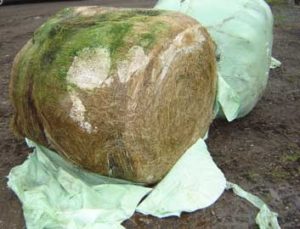What Are Mycotoxins?
18 October 2017 Mycotoxins are toxic substances produced through growth of certain fungal species on grain and other materials in the environment. The can adversely affect animal and human health if eaten in sufficient quantity.
Mycotoxins are toxic substances produced through growth of certain fungal species on grain and other materials in the environment. The can adversely affect animal and human health if eaten in sufficient quantity.
In the UK, contamination by the fungi Fusarium species is common, especially in moist, cool conditions. These species need high relative humidity (more than 70%) or grain moisture of more than 22% for growth. (This is why we need additives to store moist grain/feeds.) The fungi can contaminate growing crops (mainly wheat and barley- with the risk highest when there is high rainfall at flowering (GS59) or pre-harvest) or stored grain that has a high moisture content. They can also contaminate finished feed that is stored in unsuitable conditions or when left to go stale in feeders in warm, humid buildings.
Other fungi can contaminate grains and feed under such conditions with the Aspergillus and Penicillium species also producing toxins but there are many other species that grow as moulds but don’t produce toxins.
Part of the problem is that contamination with mycotoxins is not always obvious and it can be a ‘hidden’ problem in finished feed and feeding systems.
Can We Test For Mycotoxins?
Yes, feed samples can be tested but the distribution of toxins can be patchy so ‘representative’ sampling is needed. Animals can be tested by your vet taking blood samples while they are being fed the suspect feed. Urine is a good sample for some mycotoxins
How Do Mycotoxin Binders Work?
There are different types of mycotoxin binders that work in different ways. It is a complex subject and there are an increasing number of products on the market. Basically, they include feed adsorbents or chemicals that are intended to keep the toxin within the bowel, reducing the amount that gets absorbed into the blood stream. The main groups of compounds are:
- Clay-based products (bentonite or zeolite)
- Charcoal-based products
- Hydrated sodium calcium aluminosilicates
- (HSCA’s)
- Yeast-based glucomannan polymer
- adsorbents (GMA’s)
All of these products are thought to help in reducing absorption however this can be variable
What Can I Do On Farm To Prevent Mycotoxin Problems?
- Use good quality feed from a reputable supplier and store it in the correct way (cool, dry conditions).
- Home grown cereals need to be harvested with a low moisture content, dried, cooled and storage free of infestation, vermin and weather tight to allow the grain to be stored safely.
- Grain harvested moist must be treated with an appropriate preservative eg urea, acid, inoculants, etc.
- Inspect grain storage bins, mixing equipment, feed lines and feeders for caking, moulding or musty odours.
- On a regular basis, removing all contaminated feed, clean equipment and decontaminate storage areas with hypochlorite (laundry bleach) to kill off fungal contamination.
Jill Thomson, jill.thomson@sac.co.uk
Sign up to the FAS newsletter
Receive updates on news, events and publications from Scotland’s Farm Advisory Service
